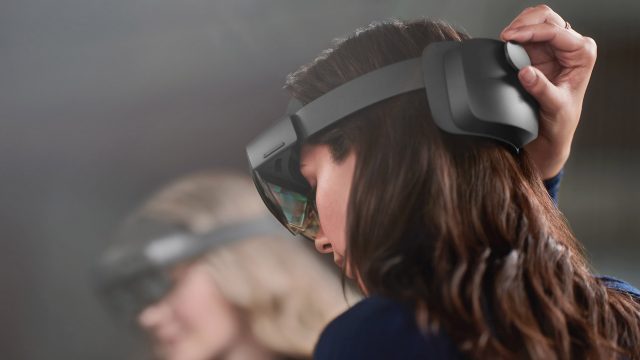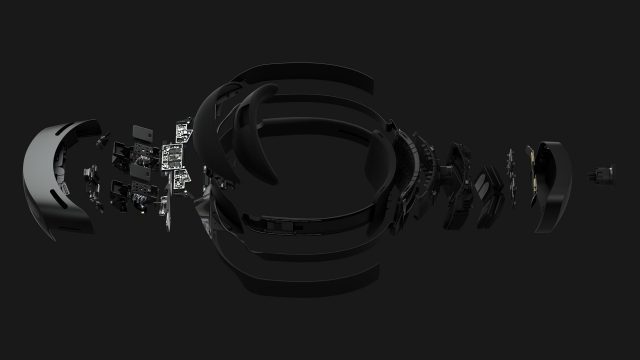Microsoft today revealed HoloLens 2, a standalone AR headset and successor to the original HoloLens. While the company is still keeping some specs under wraps, a list of official specs gives further insight into the new headset.
HoloLens 2 was announced today boasting a field of view that’s purportedly twice as large as the original, along with a sharp 47 pixels per degree resolution, hand-tracking, eye-tracking, and improved comfort.


Along with the announcement came some official specifications which we’ll post in full below, but first some highlights:
Resolution
Microsoft isn’t giving the exact resolution but says that the resolution is “2K” per-eye with 2.5K light points per radian; which works out 47 pixels per degree, which we understand to be the same pixel density as the original headset (very sharp compared to contemporary consumer VR headsets). On stage at the reveal, the company made the point that they’ve maintained 47 pixels per degree despite more than doubling the field of view of the headset.
Aspect Ratio
The specs note a 3:2 aspect ratio for the display which is more square than the original headset’s 16:9 ratio. 3:2 is arguably a better shape for an AR headset because it distributes the display more evenly across the horizontal and vertical portions of our vision, though which is best ultimately depends on the use-case.
Field of View
The field of view of the original HoloLens is around 30 degrees horizontally and Microsoft says that HoloLens 2 offers “more than double” the field of view of the original, but isn’t saying in exactly which dimension (which matters considering the change in aspect ratio). It seems we can expect around a 65 degree horizontal field of view, though we’ve reached out to Microsoft for more details on their measurements.
“Eye-based Rendering”
There’s minimal detail on this, but the HoloLens 2 specs indicate an “eye-based rendering” feature which offers “display optimization for 3D eye position.” We know that the headset includes eye-tracking, and this suggests that the system takes into account not only the IPD (distance between the eyes) of the user, but also the lens-eye distance to adjust rendering for ideal visuals. This should mean a more comfortable experience from user-to-user with automatic software adjustment, though it doesn’t appear at this point that there’s any mechanical adjustments for IPD, nor any indication of the minimum or maximum IPD supported.
Processor
Rumors have turned out to be correct; HoloLens 2 uses a Snapdragon 850 processor, along with Microsoft’s own 2nd generation ‘Holographic Processing Unit’, a co-processor which handles sensor input. The original HoloLens headset used an Intel x86 processor.
Battery Life
Microsoft claims “2–3 hours of active use” for battery life which isn’t exactly stellar, and remains roughly in line with the original HoloLens. This will surely be a sticking point for usability, but with an on-board USB-C connector and “quick charge” capability, it may be possible to significantly extend battery life with an external battery pack depending upon whether or not this would lead to thermal issues.
Glasses
The specs say that HoloLens 2 “fits over glasses,” which is certainly a plus, but it isn’t clear if glasses will impact the eye-tracking used in the headset.
Top Strap
HoloLens 2 also comes with an optional top strap which runs from the back of the headstrap to the front for added comfort. This wasn’t shown at all during the reveal, but could add significant comfort by better distributing weight across the top of the head.
What We Don’t Know
Aside from lacking specifics on field of view and resolution, weight and brightness are two other major unknowns. Microsoft says that HoloLens 2 ‘increases comfort by 3x’ over the original, but it isn’t entirely clear how they’ve quantified comfort. However it seems clear that they’ve taken steps to better balance the weight of the headset by moving some of the bulk to the rear of the device.
Brightness (both minimum and maximum) is important because it dictates in which environments the headset will be usable. Without enough brightness from the display, outdoor daytime use-case could be rendered useless, while the same goes for minimum brightness in dark environments. Hopefully we’ll learn more about all of these aspects soon.
Here’s the full HoloLens 2 specs that Microsoft has revealed thus far:
Display
- Optics: See-through holographic lenses (waveguides)
- Resolution: 2K 3:2 light engines
- Holographic Density: >2.5K radiants (light points per radian)
- Eye-based Rendering: Display optimization for 3D eye position
Sensors & Audio
- Depth: Azure Kinect sensor
- IMU: Accelerometer, gyroscope, magnetometer
- Camera: 8MP stills, 1080p30 video
- Microphone Array: 5 channels
- Speakers: Built-in, spatial audio
Human Understanding
- Hand Tracking: Two-handed fully articulated model, direct manipulation
- Eye Tracking: Real-time tracking
- Voice: Command and control on-device, Natural Language with internet connectivity
Environmental Understanding
- 6DoF Tracking: World-scale positional tracking
- Spatial Mapping: Real-time environment mesh
- Mixed Reality Capture: Mixed hologram and physical environment photos and videos
Compute & Connectivity
- SoC: Qualcomm Snapdragon 850 Compute Platform
- HPU: 2nd generation custom-built Holographic Processing Unit
- WiFi: 802.11ac 2×2
- Bluetooth: 5.0
- USB: USB Type-C
Power
- 2–3 hours of active use
- Charging: USB power delivery – fast charging
- Thermals: Passively cooled
Fit
- Single Size: Fits over glasses, size using adjustment dial
Software
- Windows Holographic OS
- Edge
- Remote Assist
- Layout
- Guides
- 3D Viewer
- OneDrive for Business
HoloLens 2 is available for pre-order today starting at $3,500.

